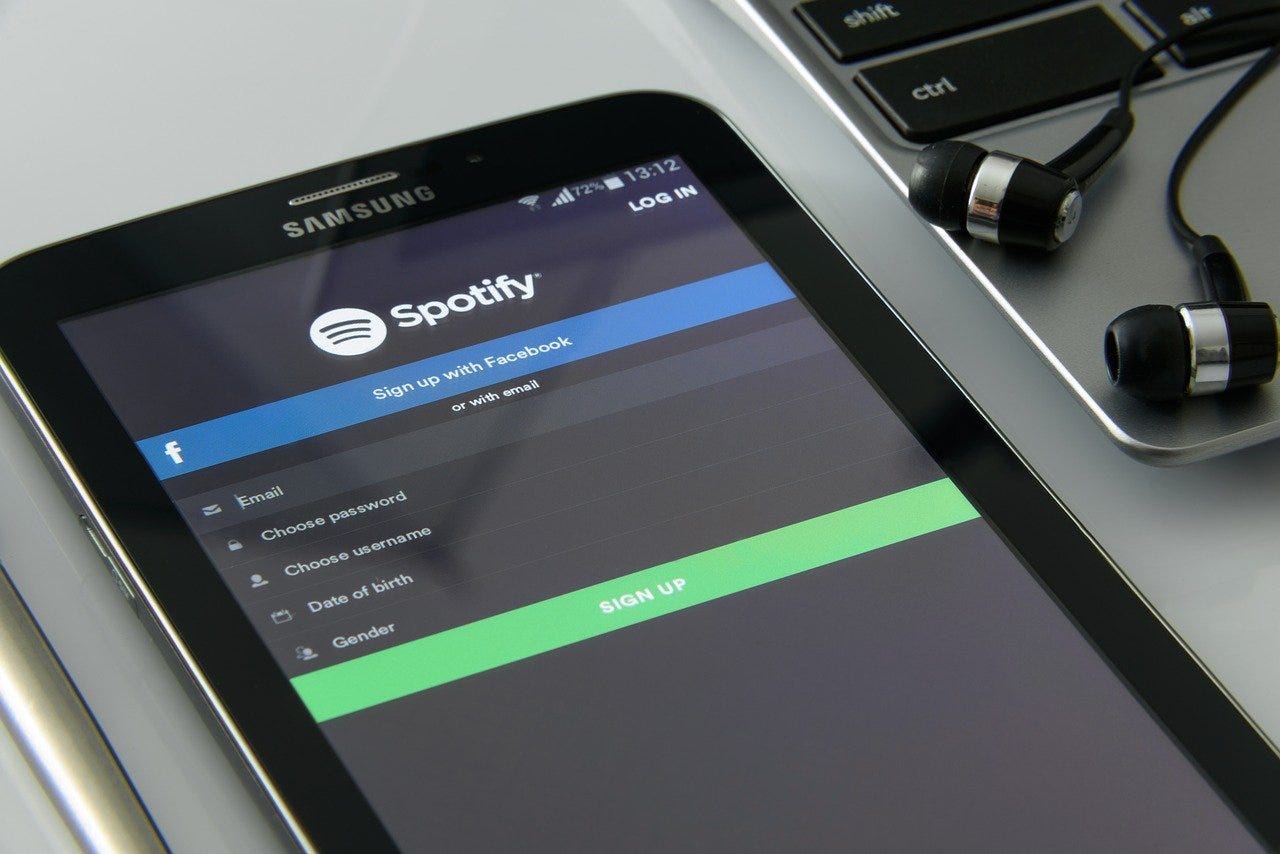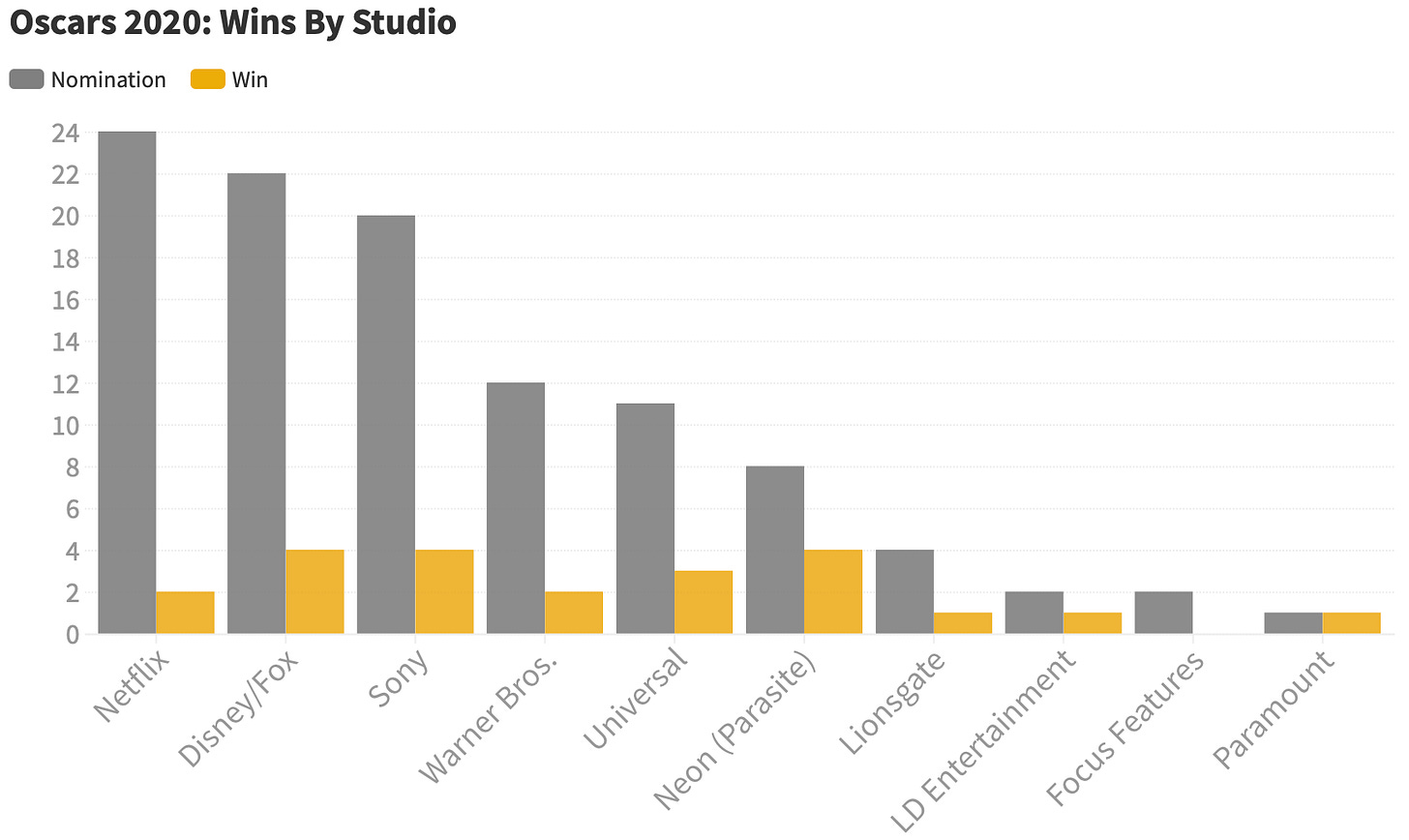Digital Media Trends for 2020+
What to expect in digital this year? How about those millions Spotify spends on podcasts, is it worth it? Will we care about the Oscars in 2030? Enjoy the FWIW newsletter, David.
In this edition
Digital Media Trends in 2020 📊 📈 - lots of useful charts
Will Spotify big bets pay off? 🎙️
#Oscars2030 maybe won’t matter 🎥 🍿
The rest of the news in short bites 💬
Digital Media Trends in 2020

📷 by Rafael De Nadai on Unsplash
In the past weeks, there have been a few interesting reports published that paint a pretty comprehensive picture of the years to come in terms of digital media & tech.
1) Streaming is growing, though TV remains massive
If I wanted to make a case for TV, it would go probably like this:
Everyone is talking about streaming, buying Disney and Netflix stock, but if you look at the hard evidence, traditional TV accounts for more then 80% of TV watching time among adults based on the recent Nielsen report, which nearly 9 hours a day. Also, TV is predicted to maintain around 31.5% of global ad spend share (Olympics, Euros and US presidential elections). It’s going to be a solid year for TV.

But, you could make a counterpoint:
Investment bank Piper Jaffray found in their survey teens were spending more time on YouTube (37%) than Netflix (35%). Which is a change from the earlier survey in spring last year, when Netflix was first and YouTube second. Still, cable TV was only 12% and according to analysts, households continue to migrate to online video services.

According to Ofcom’s second annual Media Nations report from last year, the situation is very similar in the UK, where the decline in TV viewing among teens is accelerating the most.
Takeaways 🤔
It’s not too late to start your investment into the digital video (yes, you have time to become a YouTuber or start writing on your pitch for Netflix, Disney+, Apple TV+, Amazon Prime Video, Peacock, HBO Max, Quibi…)
The TV is here to stay, at least for the next decade.
No, you won’t reach teens on TV anymore.
2) Don’t miss the e-commerce train
Although e-commerce has been growing massively, it accounts for about 15% of addressable retail sales (eMarketer). The situation is slightly different in countries around the world, in China e-commerce makes up 25%, South Korea 22%, France 10%, India 3%.

According to the Piper Jaffray survey mentioned above, 52% of US teens claim Amazon as their favorite online shopping website followed by Nike (4%).
And there are hundreds of direct to consumer brands to watch in 2020, just look at the long list, which IAB put together.

Takeaways 🤔
Maybe you won’t create the next Amazon, but apparently there is an expanding e-commerce universe where you can carve out a piece of pie for yourself.
From the perspective of digital publishers, this means a way to grow (or at least start) their affiliate content businesses. Look at BuzzFeed, commerce revenue (which includes affiliate) made up 21% of the company’s revenue in 2019 (up from 9% in 2017). Digital other revenues for The New York Times company, which consist primarily of affiliate referral revenue, television and film revenue and digital licensing revenue, totaled $27.9 million for the fourth quarter and $79.8 million for the full year 2019.
3) Mobile finally first & big tech dominates the internet
Similarweb published its 2020 State of Digital Report. It’s full of interesting data:
web traffic was 10% higher in 2019 than in 2018
mobile web traffic has surpassed desktop
users spend half the time on mobile, the visits are shorter compared to desktop
Google gets the biggest traffic on the web, followed by YouTube and Facebook

adult content and gambling have best adapted to mobile-first
streaming videos, search and social networks are some of the most consolidated industries, as over 80% of category traffic arrives at the top 10 sites for each
Amazon has not only increased traffic to its site by 7.4% (only etsy.com and kohls.com had greater relative change), its app installations and usage have nearly doubled over the past year
overall outgoing display ads traffic increased by 23.9% YoY

monthly traffic to social networks hasn’t changed, though it has shifted towards YouTube, Facebook taking second place
the world's messaging space continues to be dominated by Facebook and its owned property, WhatsApp: leading in 168 countries

Takeaways 🤔
Display advertising isn’t about to go away anytime soon even though you might be reading more and more about successful subscription business across the board.
You should have a presence on Google, YouTube, and Facebook because that’s basically the internet now ¯\_(ツ)_/¯
Here’s another Digital 2020 report – published by DataReportal in partnership with We Are Social and Hootsuite.

Spotify’s big bet: Podcasting

As Lucas Shaw in Bloomberg put it - Spotify has now spent more than $600 million to acquire four companies that can accelerate its podcasting business - the Ringer, Gimlet Media, Anchor, and Parcast. Also, there was the online music studio Soundtrap acquisition, which eventually added tools for podcasters (storytellers, as they put it).
The streaming giant now has everything that it could possibly assemble to have “all the arms” of the podcasting operation - a tech platform, free podcast hosting, ad tech, and world-class content creators.
Spotify says, podcasts are driving engagement and serve as a pathway to subscription. Also, the company has built ad tech specifically for the medium and is testing ads within its own podcasts. It’s believed that eventually there will be ads in other podcasts as well. No surprise there. The question is whether creators will get a cut and what will be the rules going forward.
Important note - Spotify’s ad business is about 10% of the company’s overall revenue, which is $740 million. Podcasting is not even a billion-dollar industry yet (IAB).

If you asked me, I would say Spotify has all the right pieces and the next step is to put it all together, possibly before Apple Podcasts start doing something. I mean, it would be about time.
In the end, advertising is not the only end game here. Exclusive content has been a driver of subscriptions for other streaming businesses (Netflix, Disney+). A good story is a good story whether it’s text, video or audio.
You see also news media publishers turning towards audio as an untapped opportunity. Take the Danish newspaper Zetland in their own words:
We began reading a selection of our articles aloud, and during the summer of 2017 Zetland began publishing all articles as audio. The decision of publishing all articles in an audio version was a completetransformation of our media in a relatively short time. And it turned out to be a great success. In two months 40% of the consumption was audio, in less than 6 months it was 50%. We were very surprised at the scale and the speed of this. Today our members listen far more than they read the articles of the day. 70 percent of the consumption is the audio version of the articles.

#Oscars2030, will you care?
It’s always a tricky business to predict that something which has existed for almost a century will cease to exist. Not that it would be completely gone, the public just won’t care. I mean, take Yahoo. Did you know the company redesigned its logo last year?
This is my favorite winners/losers chart of the Oscars:

Netflix stands out. The company spent around $70 million on advertising its nominees to the Academy. It's nothing compared to the $15 billion spent on content in 2019 and reported $17 billion it plans to spend in 2020.
The streaming company will be OK without the Academy. The question stands whether the Academy will be fine without the streaming companies creating buzz around the awards.
The number of tickets sold per person in the U.S. hit a 92-year low. Yet there are more theatrically released films than ever before. The streaming platforms are flooding the viewers with endless content in their own living rooms.
In a world in which fewer and fewer people care about theatrical releases, because they expect the movies on their streaming platform asap, I don’t see much use for Academy Awards which have not been very receptive to streaming giants.
Finally, this year’s ceremony was the least viewed ever. Market research firm Nielsen revealed that just 📉 23.6 million people watched the ceremony, down from 29.5 million last year.

The rest of the news in short bites
👀 Morning Brew, on the back of a single newsletter, grew to $13m in revenue with 33 employees. 89% of that comes from the newsletter operations and the rest from the podcast division. The main newsletter, focusing on business news, has 1,8 million subscribers and the other three (tech, retail, politics) have 60k to 160k. (Digiday)
Here’s an older story by Morning Brew’s senior product lead on how they built their audience with a smart referral program. Basically, they have milestone incentives based on how many new subscribers you have referred to them. Let’s say based on your referral 3 others subscribed to Morning Brew, you will get access to an exclusive Sunday newsletter, for 5 you get stickers, for 10 gain access to our exclusive “Insider” community and so on.
⌚ The Apple Watch outsold the entire Swiss watch industry by 10 million units last year. Apple sold 31 million smartwatches. According to the latest numbers, Apple has a leading 50% market share, followed by Samsung with 13% and third place goes to Fitbit, now owned by Google, with an 11% market share. (Strategy Analytics)
🎧 There is a new online podcast course focused on audience growth. RadioPublic has a new twelve-part video series on how to create an audience growth strategy using websites, email newsletters, and social media to gain and retain listeners. (RadioPublic)
PRX and the Google Podcasts creator program has also created a 10-part instructional video series to support early-stage podcasters around the world back in October 2019.
🗞️ Case studies in successfully monetizing local news. The Athletic is focusing on coverage of the local sports team, they create original content via insider courses and put it behind a paywall. The site will hit a million subscribers any day. Technically Media writes stories of local tech communities in big US cities, organizes live events and has job boards (companies have to pay to post). (Whats’s New in Publishing, WAN-IFRA)
Playlist of the Week: The New Pope OST - Apple Music | Spotify
TV Show of the Week: Locke & Key [Netflix]
Catch me on Twitter or LinkedIn. Was this forwarded to you? Subscribe over here 👈



